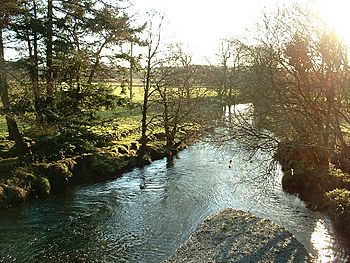Afon Dwyfor facts for kids
Quick facts for kids Afon Dwyfor |
|
|---|---|

The Afon Dwyfor as it leaves Cwm Pennant
|
|
| Country | United Kingdom, Wales |
| Physical characteristics | |
| Main source | Cwm Dwyfor, Eifionydd Hills 460 ft (140 m) 53°01′13″N 4°10′41″W / 53.0204°N 4.1780°W |
| River mouth | Tremadog Bay, Cardigan Bay 0 ft (0 m) 52°54′38″N 4°15′38″W / 52.9105°N 4.2606°W |
| Length | 12.5 mi (20.1 km) |
The Afon Dwyfor is a river in north-west Wales. It flows through Gwynedd, a county known for its beautiful landscapes. This river is about 12.5 miles (20.1 km) long. It starts high up in the mountains and eventually flows into the sea.
Contents
About the Afon Dwyfor
The Afon Dwyfor is an important river in the Gwynedd area of Wales. It is one of the many rivers that help shape the Welsh countryside. The river's journey takes it from high mountains down to the coast.
Where the River Flows
The Afon Dwyfor begins in a valley called Cwm Dwyfor. This valley is at the top of Cwm Pennant. As it flows, many smaller streams join it. These streams come from the mountains around, like Mynydd Graig Goch and Moel Hebog.
The river then flows southwest towards a village called Dolbenmaen. After Dolbenmaen, it leaves the Snowdonia National Park. It takes a short turn west, then heads south, and then southwest again. Its path leads it to the village of Llanystumdwy.
Beyond Llanystumdwy, the river continues towards the coast. It finally reaches Tremadog Bay, which is part of Cardigan Bay. The river's mouth has been moved almost a mile to the east. This happened because of a natural process called longshore drift, which moves sand and pebbles along the coast.
Other Rivers Joining In
The Afon Dwyfor has two main rivers that join it.
- The Afon Henwy joins the Afon Dwyfor on its left side, just above Dolbenmaen.
- The Afon Dwyfach joins it on its right side, west of Llanystumdwy.
The Afon Dwyfach itself starts in a flat area. This area is west of the A487 road between Bryncir and Llanllyfni. The Afon Dwyfach generally flows south before meeting the Afon Dwyfor.
What the Name Means
The name 'Afon Dwyfor' comes from the Welsh language. It means 'the big holy river'. The word 'for' is a shorter version of 'fawr', which means 'large' or 'big'. In 1838, the name 'Dwyfawr' was recorded.
The 'Afon Dwyfach' has a similar meaning. It means 'the little holy river'. There is an old Welsh legend about two characters, Dwyfan and Dwyfach. This legend is connected to these two rivers.
History Along the River
Many roads and paths cross the Afon Dwyfor. Important roads like the A487, B4411, and A497 road cross it. The railway line between Criccieth and Pwllheli also crosses the river.
Near Dolbenmaen, people believe a Roman road once crossed the river. This Roman road was on its way to a Roman fort called Segontium. In the Middle Ages, a type of castle called a Motte-and-bailey castle stood here. This castle was once home to Llywelyn the Great, a famous Welsh prince. It helped guard the place where the Roman road crossed the river.
Famous Grave Site
The grave of David Lloyd George is located beside the Afon Dwyfor in Llanystumdwy. David Lloyd George was a very important person in British history. He served as the Prime Minister of the United Kingdom from 1916 to 1922.
His grave is marked by a large boulder, and it does not have an inscription. Later, a special monument was built around the grave. This monument was designed by an architect named Sir Clough Williams-Ellis. It has a special Welsh poem, called an englyn, carved into slate. This poem was written by his nephew, Dr W. R. P. George, to remember him.
See also
 In Spanish: Río Dwyfor para niños
In Spanish: Río Dwyfor para niños

